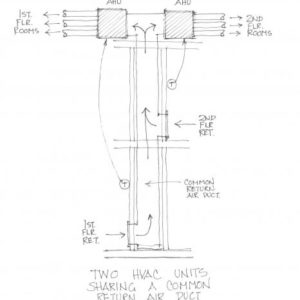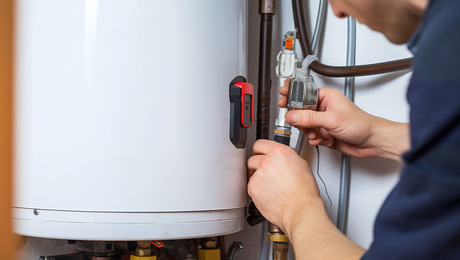What would happen if I had 2 HVAC units share a common return air duct?
I am working on the deisn for a two story single family residence that would have two airconditioning units, one for the first floor and one for the second floor. The first floor unit has a return air chase that extends from the first floor all the way up through the second floor. The second floor would have its own separate return air chase, except that the available location on the floor plan would not work in the attic; the attic space above this return air chase would not be enough to fit the air handlers.
I’ve often wondered what the effects would be if both units pulled air from a single return air duct that would split off in the attic to both units. When both units are running, then both units would be pulling air from both first and second floor, but what would happen if one unit were turned off? The other unit would still pull air from both floors (zones), but would it also back flow air through the unit that is shut down?
Are there any other issues to be concerned about? Would this arrangement compromise the efficiency of both the units?
I look forward to a reply, in the mean time, I will continue exploring other locations in the plan for the second floor return air chase, or I will have to consider using a closet unit on the second floor.
Thanks,
Michael Rouchell



















Replies
Need a flapper to prevent backflow, otherwise the air will flow as described by Bernoulli.
Don't do it
It's already hard enough to get forced air to work well. With a goofy return air setup like that it can only be worse. Find a way to install separate ductwork for the two systems. Putting the air handlers and/or ducts in the attic is a mistake, too, as the high temps cause massive energy waste when the A/C is trying to cool the house.
Even though we often say that return air is "pulled" from a given space, the fact is, that, except for gravity, air can't be pulled--it can only be pushed.
Remembering that will help you visualize what is likely to happen when only one unit is running. The supplies from that unit will push air into the spaces they serve, building a higher pressure therein, and the higher pressure there will push the return air back thru the unit.
However, the picture gets more complex depending on how the entire system is balanced and how freely the supply air from one unit can flow to the spaces served by the 2nd unit. In other words, the higher pressure from the spaces served by the lower unii might find an easier path by flowing upstairs and thru a less restrictive path via the upstairs returns or supplies.
The Bernoulli effect that Junkhound mentions would also create lesser pressure that will allow some airflow from the upper unit's ducts, either supply or return, or both, again depending on how much resistance each path has.
Regardless of where the return air comes from, the supplies of the unit that is actually chilling the air will be forcing cool air into the spaces it serves, and if that supply air flows with sufficient velocity to throw and mix, the spaces will be cooled.
The key is to have accurate room-by-room load calculations done, and then size the equipment and ducts accordingly.
What?
rdesigns wrote:
Even though we often say that return air is "pulled" from a given space, the fact is, that, except for gravity, air can't be pulled--it can only be pushed.
I'm not sure how this applies to blower door testing, which I do a lot of. Set up a fan in the door, pull air out of the house. I'm pretty sure I'm not pressurizing the outdoors, so how is the indoor air being "pushed" in this situation?
Uh, the outdoors is already pressurized -- about
1614.7 PSI.Does that
answer the question??
You're pushing the air out of the house, creating lower pressure in the house. The higher pressure outside (which I just looked up and found is 14.7 PSI) then forces air in through whatever air leaks there are. Nothing is "pulled".
Dunno, man
... it seems to me like you're pulling air out of the house. Maybe what you're saying is that the air immediately on the downstream side of the fan is being pushed and is pulling air behind it from the other side of the fan. Kinda different phenomenon than what was stated above about the return air being pushed by the supply air... that's happening in a closed environment where a pressure differential is created in a large area.
Nothing is being "pulled",
Nothing is being "pulled", though it kinda works to talk about "pulling" air, as a conceptual shortcut.
It's all based on pressure differentials. The fan blades push air out (by giving the air molecules momentum), creating a region of low pressure behind it. Since nature abhors a vacuum, air from elsewhere is pushed (by atmospheric pressure) toward the region of low pressure.
Thanks for the clarification on this. The discussion happened whilst I was not checking the site over the weekend.
The fact that only gravity can pull air can be a hard concept to accept, and in most discussions, it doesn't matter much--kind of like trying to correct others when they (or, I) say that the sun is going down. It's not really going down, it's just the earth's rotation making it appear that way. But that doesn't stop me or anybody I know from saying it's going down. Only in certain professions does it matter, like astronomy or astronautics.
Likewise, HVAC designers and contractors are among the few to whom it matters that air can't be pulled by mechanical means, even though atmospheric pressure makes it appear that way.
It certainly isn't intuitive
as applied to a blower door test. The fan blades are in plane with the building shell. There is a low pressure area immediately to the inside of the fan... but doesn't some air have to be pulled out of that area in order to create the low pressure? We can't pressurize the outdoors to force air into the house, we have to depressurize the house.
It makes perfect sense applied to a forced air system within a building. Supply air pushes return air.
Probably the deceptive factor when thinking about a blower door test is that the air in and around the house is already pressurized by atmosheric pressure (as DanH mentioned in one of his posts.)
So, when the fan pushes some of that pressurized air from the house, an area of lower pressure is temporarily created within the house, and atmospheric pressure begins pushing air into the house from various leaks in its envelope in response to the lower pressure that is caused by the fan blades pushing air.
Same thing happens when you suck on a straw--your diaphragm expands your lungs thereby creating a low pressure zone within your airway, which includes the straw, and it is atmospheric pressure on the surface of the drink that pushes it up the straw.
Another example of actual pushing that may seem to be counter-intuitive is the action of hot gases rising in a flue--as seen in a gas-fired water heater. It's true that the heated gases become lighter than the surrounding air, but it is actually the pressure of the surrounding air that pushes the lighter flue gases up and out.
Please forgive my excessive, and maybe unwanted, harping on this subject..
All is forgiven
and I still don't see how the fan could push air out of the house. If I am understanding the hypothesis here, the fan can only push air, and the only air it can push is already outside of the house.
On the hot-air-rises topic... that one I understand. It's actually the colder, denser, less buoyant air that's falling and pushing the warmer air out of the way.
The air the fan pushes is just ahead of the blades. With a conventional bladed fan the blades "slice" the air like a knife and "throw" each slice outward. This leaves behind a relative vacuum, and thus the higher pressure elsewhere in the house causes air to flow toward the fan.
Despite the other replies, the universe will not implode if you do this. What will happen is that when one unit is running and the other isn't, a modest amount of return air will be drawn from the "off" area, and an equally modest amount of conditioned air will be drawn from the "on" area into the "off" area (assuming that the whole structure is reasonably well sealed).
We've had this arrangement for 36 years, though about 10 years ago we had the two furnaces replaced with a single one and a zone system (which, from the standpoint of this discussion produces exactly the same issues). And, of course, with a zoned system there's no option but to use a single return trunk. And in 36 years we've not seen any problems attributable to the setup.
Assuming it's sized properly there should be no issues sharing the return. If air flows backward through the one that is off, you may collect dirt on the coil. However, if your chase is big enough for the size of two, you might consider running them both in the same chase. Having them being undersized would not be a good idea.